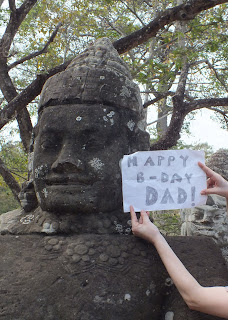 |
| Angkor Wat layout/floorplan, image from Wikimedia Commons |
 |
| Angkor Wat from the ground, our photo |
 |
| Angkor Wat from the air; again, thanks to Wikimedia Commons. See why we opposed SOPA/PIPA? |
So the moats get dug up for two reasons: one, you move the land you dug up into the middle, to support the weight of the huge temple you're about to build. Otherwise, the thing will sink into the ground under its own weight. Second, the moat provides a drainage location for the huge amounts of rain which come down during the monsoon season. They may also have theological significance, as many temples reference the Hindu myth of the churning of the ocean of milk. I have this idea that the conversation between the kings and their designers went something like this:
Architect: Which story would you like for this first temple, sir?
King: ... What about that ocean of milk story? That's a good one.
Architect: Very good, Your Majesty. And the temple to honor your parents?
King: You know, I've always been fond of that churning story.
Architect: I see. Well, we can do that. Have you thought at all about your mausoleum temple?
King: (thoughtful pause) The ocean of milk?
 |
| Moat outside Bayon Temple, and creatively frustrated architect. |
The concentric squares shown in the Angkor Wat drawing are like layers of a layer cake. As you go up, you go up to the surface only; There is no "inside" of the buildings (like an Egyptian pyramid). The middle section of the cake is just cake. If you hollowed out the supporting ground (the cake part) and filled it with, say, Mystical Treasure Traps, or Tunnels o' Death, the cake would collapse in on itself due to the weight of the cake topper. (So yes, Eddie Izzard fans, it does all boil down to cake or death.)
The inside of the temple structures are often different from the outside in one way, which is in materials. To go back to the cake-and-frosting metaphor (am I hungry or what?) the cake is a substance called "laterite," which is essentially clay which bakes into a hard stone brick when exposed to air. It is porous, cheap, and locally available, just what you want for the bulk of your construction. The porousness helps with the drainage, as water seeps into the stone, down through the building, and out into the moat.
 |
| Laterite (spongy-looking rock to the right of the door) |
 |
| Laterite used as interior, visible behind sandstone |
But laterite, like cake, has no nice surface. Imagine making frosting roses out of cake itself - it would crumble. (Many older, smaller temples were just made out of brick, which has the same advantages of laterite but is better for smaller buildings. It has the same disadvantage of being very difficult to carve).
 |
| Which did not stop them from trying. |
 |
| Lolei Temple |
 |
| Stucco, brick, and Justin. |




Which can be used to decorative effect:
 |
There is one final danger with sandstone: the carving may be so precise and detailed that it seems real.
 | ||
| One of these photos is not of sandstone. Can you tell which? |

































